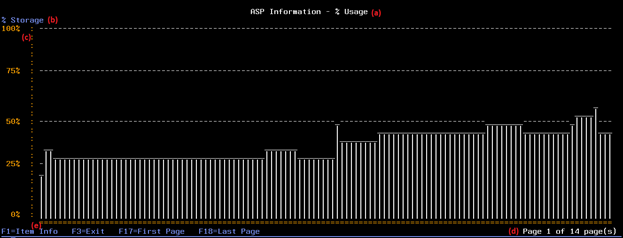Difference between revisions of "Green-screen Chart/Graph"
From MidrangeWiki
(→Screen Layout) |
(→Screen Layout) |
||
| Line 17: | Line 17: | ||
:d. If the number of data points exceed the screen width, the program will create additional pages. Page Up/Down will show the rest of the entries. If you want to jump to the 1st page, press F17, or last page press F18. | :d. If the number of data points exceed the screen width, the program will create additional pages. Page Up/Down will show the rest of the entries. If you want to jump to the 1st page, press F17, or last page press F18. | ||
:e. If you position your cursor on any data item/column, and press F1, the program will display information about the data point | :e. If you position your cursor on any data item/column, and press F1, the program will display information about the data point | ||
| + | |||
| + | [[File:GenChart_-_Item_Information.png]] | ||
==Objects== | ==Objects== | ||
Revision as of 16:29, 8 June 2021
=Green-screen Chart/Graph
Background
It is sometimes useful to display a graph of values on the AS400 green-screen. Although there are commercial products available for the AS400, these are often difficult to use and not available everywhere. This product was designed to allow for a simple text-based line-graph to be displayed on the screen. It will take a data-structure from another program, and build up the screen accordingly.
The program has been written to work correctly on either a wide screen (27x132) or a normal screen(24x80).
Screen Layout
- a. This is the header as passed to the program
- b. This is the Y-label, as passed to the program
- c. The Y-axis values will be build based on the chart type or the chart calc function
- d. If the number of data points exceed the screen width, the program will create additional pages. Page Up/Down will show the rest of the entries. If you want to jump to the 1st page, press F17, or last page press F18.
- e. If you position your cursor on any data item/column, and press F1, the program will display information about the data point
Objects
The following objects will be used by the program:
- a. GENCHART#D - Display File
- b. GENCHART#R – RPG Program
GenChart Program Parameters
The GENCHART#R program requires the following parameters:
- a. Data structure (see point 4):
- - The data structure will be passed from your program, to the GENCHART#R program, by using pointers. When you call the program, the variable has to use %ADDR(DSNAME).
- b. Heading:
- - Char (100).
- - The heading you need for your chart
- c. Y-Axis Label:
- - Char(30)
- - Here you can specify a label for the Y-Axis.
- - Label will be affected by the Chart Type variable
- d. Total Items:
- - Int(10)
- - Specify the number of values to be passed via the DataStructure
- e. Max Value:
- - Packed(31:2)
- - Specify the Maximum value. This is needed to determine the sizing of the bars
- f. Chart Type
- - Char(10)
- - Allows for two types of charts. Can be either
- *PCT: Determine %, betwee max value and actual value
- *NORMAL: Display the values on the screen as they are
- g. Chart Calc:
- - Char(10)
- - If the values are too big, the program can scale them. Allowed values are:
- *NONE – Keep the values as is
- *TB – Scale the values in Terrabytes
- *GB – Scale the values in Gigabytes
- *KB – Scale the values in Megabytes
- *KB – Scale the values in Kilobytes

